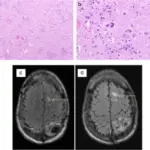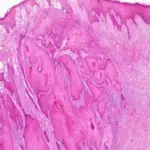Tuberous sclerosis is an autosomal genetic disorder affecting cellular differentiation, multiplication, and migration.
What is the Pathology of Tuberous Sclerosis?
The pathology of tuberous sclerosis is: the gross and microscopic examination in a genetic illness affecting cellular differentiation, multiplication, and migration, resultant in hamartomatous lesions.
-Etiology: The cause of tuberous sclerosis is the mutation of genes.
-Genes involved: TSC-1, TSC-2 genes.
-Pathogenesis: The sequence of events that lead to tuberous sclerosis is a result of mTOR constitutively activation in hamartin or tuberin.
-Morphology: The morphology associated with tuberous sclerosis shows patches of light-colored skin, reddish bumps in the skin, and the nails, pink or dark in color.
-Histology: Atypia.
How does Tuberous Sclerosis Present?
Patients with tuberous sclerosis typically affect both sexes equally and the onset is at a very early age. The symptoms, features, and clinical findings associated with tuberous sclerosis include adenoma sebaceum, cardiac disease, retinal astrocytoma, giant ependymal astrocytoma.
How is Tuberous Sclerosis Diagnosed?
The tuberous sclerosis is diagnosed CT scan, blood workups, renal ultrasound, echocardiography.
How is Tuberous Sclerosis Treated?
The tuberous sclerosis is treated mainly by the use of antiepileptic medication, surgery, cryotherapy.
What is the Prognosis of Tuberous Sclerosis?
The prognosis of tuberous sclerosis is fair depending on the stage the disease is.



